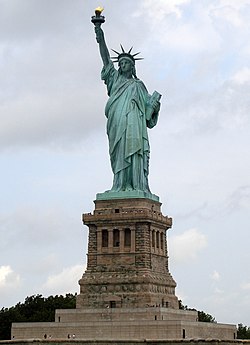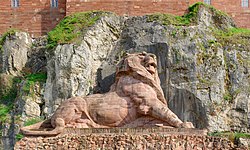Statue of Liberty
The Statue of Liberty[a] (officially named Liberty Enlightening the World[1] and sometimes referred to as Lady Liberty) is a monument symbolising the United States. The statue is placed on Liberty Island, near New York City Harbor. The statue commemorates 100 years since the signing of the United States Declaration of Independence. It was given to the United States by the people of France as a gift in 1886, to represent the friendship between the two countries established during the American Revolution.[2] It represents a woman wearing a robe, a crown and sandals, trampling a broken chain. She has a torch in her raised right hand and in her left hand she holds a tablet bearing the date of the Declaration of Independence JULY IV MDCCLXXVI (1776).[3] The statue is on Liberty Island in New York Harbor,[4] and it welcomes visitors, immigrants, and returning Americans travelling by ship.[5]
The Statue of Liberty is based on the Greek god Libertas, also known as Eleutheria, the Goddess of Liberty, and was given a temple on the Aventine Hill in c. 238 BC.[6]
History
Frédéric Bartholdi sculpted the statue[7] and he obtained a U.S. patent for the structure.[8] Maurice Koechlin, who was chief engineer of Gustave Eiffel's engineering company and designer of the Eiffel Tower, designed the internal structure. The pedestal was designed by the architect Richard Morris Hunt. Eugène Viollet-le-Duc chose copper in the construction of the statue, and for the adoption of the repoussé construction technique, where a malleable metal is hammered on the reverse side.[9]
The statue is made of a covering of pure copper, left to weather to a natural blue-green patina. It has a framework of steel (originally puddled iron). The exception is the flame of the torch, which is coated in gold leaf (originally made of copper and later altered to hold glass panes). It is on a rectangular stonework pedestal. Within the foundation is an old star fort in the shape of an irregular eleven-pointed star. The statue is 151 ft (46 m) tall, but with the pedestal and foundation, it is 305 ft (93 m) tall.
The Statue of Liberty is one of the most recognizable symbols in the world.[10] For many years it was one of the first glances of the United States for millions of immigrants and visitors after ocean voyages from around the world.
The statue is the central part of the Statue of Liberty National Monument, administered by the National Park Service. The National Monument also includes Ellis Island.
Inscriptions, plaques, and dedications
There are several metal plaques on or near the Statue of Liberty. A plaque on the copper just under the figure's feet declares that it is a colossal statue representing Liberty, designed by Bartholdi and built by the Paris firm of Gaget, Gauthier et Cie (Cie is the French abbreviation analogous to Co.). Another plaque declares the statue to be a gift from the people of the Republic of France that honors "the Alliance of the two Nations in achieving the Independence of the United States of America and attests their abiding friendship."[11] The New York committee made a plaque that commemorates the fundraising done to build the pedestal. The Freemasons put another plaque on the cornerstone.[11]
In 1903, a bronze tablet that bears the text of "The New Colossus" and commemorates Emma Lazarus was presented by friends of the poet. Until the 1986 renovation, it was mounted inside the pedestal; today it resides in the Statue of Liberty Museum in the base. It is accompanied by a tablet given by the Emma Lazarus Commemorative Committee in 1977, celebrating the poet's life.[11]
A group of five statues is at the western end of the island. They honor people involved in building the Statue of Liberty. The statues stand for two Americans—Pulitzer and Lazarus—and three Frenchmen—Bartholdi, Laboulaye, and Eiffel. The five statues were designed by Maryland sculptor Phillip Ratner.[12]
In 1984, the Statue of Liberty was designated a UNESCO World Heritage Site. The UNESCO "Statement of Significance" describes the statue as a "masterpiece of the human spirit" that "endures as a highly potent symbol—inspiring contemplation, debate and protest—of ideals such as liberty, peace, human rights, abolition of slavery, democracy and opportunity."[13]
Statue Of Liberty Media
Leaf disc dedicated to Sol Invictus, sun god of the late Roman Empire. Sol Invictus, along with Libertas the Roman goddess and personification of Liberty, influenced the design of Liberty Enlightening the World.
Bartholdi's 1880 sculpture, Lion of Belfort
Detail from a 1855–56 fresco by Constantino Brumidi in the Capitol in Washington, D.C., showing two early symbols of America: Columbia (left) and the Indian princess
Thomas Crawford's Statue of Freedom (1854–1857) tops the dome of the Capitol building in Washington.
Liberty is depicted in a contrapposto pose, with a raised right foot amidst a broken shackle and chain.
Stereoscopic image of right arm and torch of the Statue of Liberty, 1876 Centennial Exposition
The statue's head on exhibit at the Paris World's Fair, 1878
Richard Morris Hunt's pedestal under construction in June 1885
Frank Leslie's Illustrated Newspaper, June 1885, showing (clockwise from left) woodcuts of the completed statue in Paris, Bartholdi, and the statue's interior structure
Liberty Enlightening the World, or The Statue of Liberty, a stained glass window commissioned by Joseph Pulitzer to commemorate fundraising for the pedestal. Originally installed in the New York World Building, it is currently located in Pulitzer Hall at Columbia University.
Related pages
Notes
References
- ↑ "Creating the Statue of Liberty". National Park Service. Retrieved August 16, 2020.
- ↑ "Statue of Liberty". National Park Service. 2006-04-28. Retrieved 2008-07-24.
- ↑ July 4, 1776 in roman numerals : see File:Statue liberty22.jpg
- ↑ "Statue of Liberty National Monument". National Park Service. 2007-12-31. Retrieved 2008-07-24.
- ↑ Crown of Statue of Liberty may reopen to public soon. Xinhua News Agency. 2008-07-05. http://news.xinhuanet.com/english/2008-07/05/content_8496225.htm. Retrieved 2008-07-24.
- ↑ "The Goddess: Libertas – Mystical Shores". Archived from the original on 2021-10-01. Retrieved 2021-10-01.
- ↑ "Statue of Liberty National Monument - History & Culture". National Park Service. 2006-10-05. Retrieved 2008-07-24.
- ↑ Bellis, Mary. "Statue of Liberty - Frederic Auguste Bartholdi". About.com. Retrieved 2008-07-24.[dead link]
- ↑ "June 17, 1885: The Statue of Liberty Arrives". CR4. 2008-06-17. Archived from the original on 2008-06-23. Retrieved 2008-07-24.
- ↑ "Statue of Liberty". HTML. Archived from the original on 2008-10-03. Retrieved 2006-06-20.
- ↑ 11.0 11.1 11.2 Moreno 2000, pp. 222–223.
- ↑ Harris 1985, p. 163.
- ↑ "Statue of Liberty". World Heritage. UNESCO. Retrieved 2010-07-19.
Further reading
- Bell, James B.; Abrams, Richard L. (1984). In Search of Liberty: The Story of the Statue of Liberty and Ellis Island. Garden City, N.Y.: Doubleday & Co. ISBN 0-385-19624-5.
- Glassberg, David (2003). "Rethinking the Statue of Liberty". National Park Service. hdl:2450/678.
- Harris, Jonathan (1985). A Statue for America: The First 100 Years of the Statue of Liberty. New York, N.Y.: Four Winds Press (a division of Macmillan Publishing Company). ISBN 0-02-742730-7.
- Hayden, Richard Seth; Despont, Thierry W. (1986). Restoring the Statue of Liberty. New York, N.Y.: McGraw-Hill Book Company. ISBN 0-07-027326-X.
- Khan, Yasmin Sabina (2010). Enlightening the World: The Creation of the Statue of Liberty. Ithaca, N.Y.: Cornell University Press. ISBN 978-0-8014-4851-5.
- Moreno, Barry (2000). The Statue of Liberty Encyclopedia. New York, N.Y.: Simon & Schuster. ISBN 9780738536897.
- Sutherland, Cara A. (2003). The Statue of Liberty. New York, N.Y.: Barnes & Noble Books. ISBN 9780760738900.
Other websites
![]() Media related to Statue of Liberty at Wikimedia Commons
Media related to Statue of Liberty at Wikimedia Commons
- Statue of Liberty National Monument
- Statue of Liberty-Ellis Island Foundation
- "A Giant's Task – Cleaning Statue of Liberty", Popular Mechanics (February 1932)
![]()











